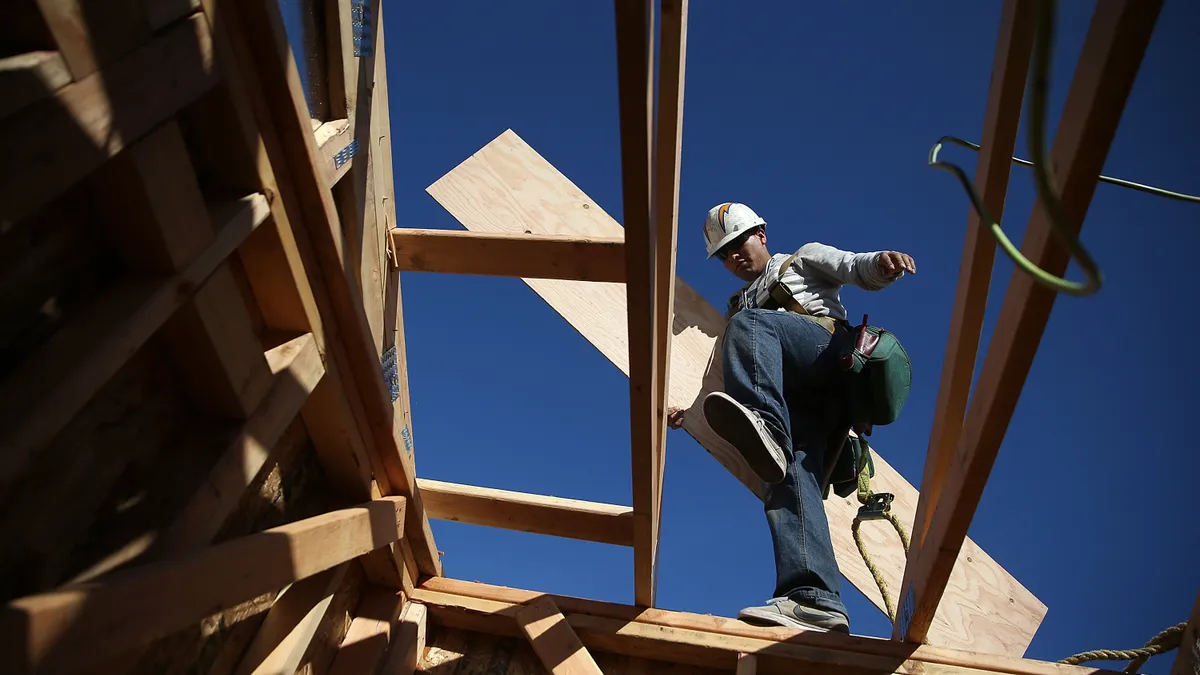Dive Brief:
- Home construction sagged last month to a low last seen during pandemic lockdowns four years ago, the Commerce Department said Thursday, as a decision by the Federal Reserve to hold borrowing costs high longer than forecast slows the U.S. housing market.
- Housing starts in May totaled 1.28 million on an annualized basis, 5.5% less than in April and 19.3% below the total for May 2023, the Commerce Department said. Building permits, which signal plans for future construction, fell to an annual rate of 1.39 million, also a four-year low and 3.8% below the April pace.
- “Builders are concerned with a high interest environment that is making it harder to get acquisition, development and construction loans,” National Association of Home Builders Chair Carl Harris said Thursday. “Higher rates for builder and developer loans, along with ongoing supply-side challenges regarding construction labor and buildable lots, are acting as headwinds for new home and apartment construction,” he said in a statement.
Dive Insight:
The freeze from the highest interest rates in more than 20 years has especially chilled the housing market which, according to the NAHB, generates as much as 18% of U.S. economic growth.
Mortgage activity fell 8.5% last month and 7.3% compared with May 2023, Freddie Mac said Thursday in a report.
Meanwhile, housing inventory “remains below the level necessary for a balanced housing market,” Freddie Mac said. “This imbalance is impacting housing affordability, which continues to remain a challenge.”
Nearly nine out of 10 consumers (86%) say now is a bad time to buy a home, Fannie Mae said, citing high mortgage rates. It noted that its Home Purchase Sentiment Index last month hit a record low.
Fed officials acknowledge that high borrowing costs have jarred U.S. housing activity while saying they need to see more evidence that inflation is falling to their 2% target before cutting the federal funds rate.
“In my travels around the region, one of the most common issues I hear about is a lack of affordable housing,” Boston Federal Reserve Bank President Susan Collins said Tuesday.
Still, “the appropriate approach to monetary policy continues to require patience, providing time for a methodical and holistic assessment of the evolving constellation of available data,” Collins said.
Policymakers on June 12 trimmed from three to one their median forecast for cuts to the main interest rate this year, responding to slower-than-expected cooling in both inflation and economic growth so far in 2024.
With inflation exceeding the Fed’s target, “an immediate cut in the federal funds rate is not on the horizon,” Freddie Mac said.
“However, in a scenario where the job market cools sufficiently to keep inflation in check, we anticipate one rate cut the latter half of the year,” the mortgage finance company said, noting that such a turn of events may lead “to a gradual easing of rates.”
Indeed, amid indications of slower consumer spending and economic growth, both 30-year and 15-year fixed-rate mortgages declined slightly in recent weeks, averaging on Thursday 6.87% and 6.13%, respectively, Freddie Mac said.
“Mortgage rates fell for the third straight week following signs of cooling inflation and market expectations of a future Fed rate cut,” Freddie Mac Chief Economist Sam Khater said Thursday in a statement. “These lower mortgage rates coupled with the gradually improving housing supply bodes well for the housing market.”
Still, Freddie Mac, and a panel of housing market experts consulted by Fannie Mae, expect the 30-year, fixed-rate mortgage to end this year no lower than 6.6%.












